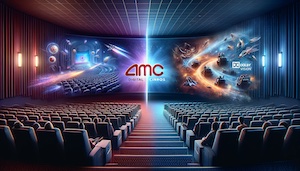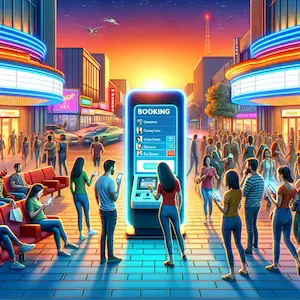In the ever-evolving world of cinema, the battle between AMC Digital and Dolby Cinemas represents a fascinating clash of titans, each offering movie-goers a unique viewing experience that pushes the boundaries of what we expect from a night out at the movies. This article delves into the nuanced differences between these two cinema powerhouses, exploring aspects such as picture quality, sound systems, seating comfort, and overall movie experience to help you decide which cinema experience best suits your preferences.
From the high-definition digital projection and sound of AMC Digital to the immersive audio-visual experience offered by Dolby Vision and Dolby Atmos technologies in Dolby Cinemas, the choices available to cinema-goers have never been more exciting or varied. Whether you’re a casual viewer looking for a comfortable evening or a cinephile seeking the pinnacle of movie-watching technology, understanding the offerings of AMC Digital and Dolby Cinemas is essential.
Join us as we compare these two leading cinema experiences side by side, providing insights into consumer preferences and delivering a verdict on which might be the better choice for different types of viewers. Plus, we’ve included a basic FAQ to address common questions, ensuring you have all the information you need to make your next movie-going experience a memorable one.

Table of Contents
Summary
The core differences between AMC Digital and Dolby Cinemas lie in their approach to delivering the ultimate cinema experience, focusing on technology, comfort, and overall viewer immersion.
Technology: AMC Digital provides high-quality digital projection and sound systems that ensure a clear, consistent viewing experience across a broad range of films. On the other hand, Dolby Cinemas take advantage of Dolby Vision and Dolby Atmos technologies. Dolby Vision offers enhanced picture quality with superior brightness, contrast, and color, making the visuals more lifelike. Dolby Atmos creates an immersive audio experience with sound that moves in three-dimensional space, including overhead, for an unparalleled auditory experience.
Seating Comfort: Both AMC Digital and Dolby Cinemas prioritize seating comfort, but Dolby Cinemas often feature more luxurious, reclining seats designed to complement the premium audio-visual experience they offer. AMC Digital also ensures a comfortable viewing experience with plush, reclining seats, focusing on providing cozy environments across a wider range of cinemas.
Overall Movie Experience: AMC Digital cinemas cater to a wide audience by offering a balanced, high-quality cinema experience that leverages modern technology without necessarily aiming for the premium end of the market. Dolby Cinemas, however, aim to provide a top-tier, immersive experience by integrating the latest advancements in cinema technology, making them a preferred choice for cinephiles and those seeking the ultimate in movie-going immersion.
In summary, while AMC Digital offers a solid and enjoyable cinema experience suitable for a broad audience, Dolby Cinemas cater to those seeking the pinnacle of cinematic technology and comfort, albeit often at a higher price point. The choice between the two ultimately depends on personal preferences, priorities, and the type of movie experience one is looking for.
Features of AMC Digital: Screen Technology
In the realm of cinema, the visual experience is paramount, and AMC Digital’s screen technology stands out as a cornerstone of their commitment to delivering an unparalleled viewing experience. At the heart of AMC Digital cinemas, the screen technology is designed to captivate audiences, drawing them into the narratives and worlds unfolding before their eyes.
AMC Digital employs state-of-the-art digital projection systems that deliver crisp, clear, and vibrant images. These projectors are equipped with advanced light engines and high-resolution capabilities, ensuring that every frame is projected with the utmost clarity and detail. Whether you’re watching a brightly lit scene or one shrouded in darkness, the technology behind AMC Digital screens ensures that the picture quality remains consistent, with deep blacks and bright whites creating a stark contrast that adds depth to the visual experience.
One of the key features of AMC Digital’s screen technology is its ability to support a wide color spectrum, enabling the display of a broader range of colors than traditional digital projection systems. This enhancement allows for more vivid and lifelike colors, making the cinematic world on screen appear more real to the audience. The richness of the color palette enhances the storytelling, allowing for more nuanced and expressive visual narratives.
Moreover, AMC Digital has embraced advancements in screen technology that reduce glare and ambient light interference, ensuring that the integrity of the image on screen is maintained, regardless of external lighting conditions. This is particularly beneficial in scenes requiring subtle visual cues or intricate details, as it ensures that viewers do not miss any critical elements of the story.
The screens used in AMC Digital cinemas are also designed to accommodate a wide range of aspect ratios, providing flexibility in presenting films as the director intended. Whether it’s an epic widescreen presentation or a more intimate standard ratio, AMC Digital’s screens can adapt, ensuring that the artistic vision is preserved and presented with fidelity.
In conclusion, the screen technology employed by AMC Digital is a testament to their dedication to providing an exceptional cinematic experience. With advanced digital projection, a wider color spectrum, and screens designed to minimize external light interference, AMC Digital offers an immersive visual experience that draws audiences into the heart of the movie, making each viewing a memorable journey.
Features of AMC Digital: Sound System
The auditory experience in a cinema plays a crucial role in immersing the audience into the film’s environment, and AMC Digital’s sound system is engineered to deliver an extraordinary sonic experience. With a focus on clarity, depth, and immersion, AMC Digital’s audio technology ensures that every whisper, soundtrack, and explosion resonates with the audience, creating an unforgettable cinematic journey.
At the core of AMC Digital’s sound system is the adoption of cutting-edge audio technologies designed to produce crystal-clear sound that envelops the audience from all directions. This multidimensional sound environment is achieved through a combination of advanced speaker systems, strategic placement, and innovative sound processing technologies. The result is a rich, detailed soundscape that perfectly complements the visual experience on screen.
One of the hallmark features of AMC Digital’s sound system is its support for premium audio formats, including Dolby Atmos and 7.1 surround sound. Dolby Atmos, in particular, offers an object-based sound experience that allows for precise placement and movement of sounds in a three-dimensional space. This capability enables filmmakers to craft audio landscapes that move with the on-screen action, adding a layer of realism and immersion that traditional sound systems cannot match. Whether it’s the rustling of leaves, the roar of a crowd, or the subtle footsteps creeping from behind, the audience is placed right at the heart of the action.
AMC Digital’s commitment to audio excellence extends to the acoustics of their theaters. Special attention is given to soundproofing and acoustic design to ensure that external noises do not intrude upon the cinematic experience. Inside the theater, the walls and seating arrangements are optimized to reduce sound absorption and reflection, ensuring that audio is distributed evenly throughout the space. This meticulous design guarantees that every seat in the house offers an optimal listening experience, free from muffled sounds or echo distortions.
Moreover, AMC Digital’s sound systems are calibrated by professional audio engineers to match the unique characteristics of each theater. This calibration process involves fine-tuning the audio output levels, frequency ranges, and speaker configurations to achieve the perfect balance of sound. It ensures that the audio is not just loud but also clear and balanced, allowing the audience to hear every detail without experiencing auditory fatigue.
In summary, the sound system features of AMC Digital represent a commitment to delivering a fully immersive and emotionally engaging cinematic experience. Through the use of advanced audio technologies, premium sound formats like Dolby Atmos, and meticulous attention to acoustic design, AMC Digital ensures that the sound in their cinemas is not just heard but felt, drawing audiences deeper into the stories unfolding before their eyes.
Features of AMC Digital: Seating Arrangements
The seating arrangements in AMC Digital cinemas are designed with the utmost consideration for comfort, sightlines, and accessibility, ensuring that every guest enjoys an optimal viewing experience from the moment they take their seat. AMC Digital’s innovative approach to seating goes beyond mere arrangement; it encompasses the quality of the seats themselves, the layout of the auditorium, and the overall atmosphere it creates for movie-goers.
At the forefront of AMC Digital’s seating features is the introduction of plush, reclining seats. These spacious seats are not just comfortable; they’re a game-changer in cinematic viewing, allowing guests to adjust their seating position to their personal preference. With a simple push of a button, viewers can recline to the perfect angle, ensuring that they can relax and immerse themselves in the movie without any discomfort. The use of high-quality materials in the seats ensures durability and cleanliness, contributing to a more enjoyable and hygienic cinema experience.
The layout of AMC Digital cinemas is meticulously planned to ensure unobstructed views from every seat. The staggered arrangement minimizes head obstruction, and the elevated rows ensure that every audience member has a clear line of sight to the screen. This thoughtful design eliminates the common frustration of having to peer around the head of the person in front, allowing for uninterrupted engagement with the film.
AMC Digital also prioritizes accessibility in their seating arrangements. Aisles are wide and easily navigable, ensuring that guests can move in and out of their rows with ease. Seats are strategically placed to accommodate guests with disabilities, with spaces for wheelchairs and companion seating readily available. This inclusive approach ensures that all guests, regardless of their physical abilities, can enjoy a comfortable and convenient cinema experience.
Another feature of AMC Digital’s seating arrangements is the reserved seating system. This system allows guests to select their preferred seats at the time of ticket purchase, ensuring that they can secure the best possible location for their viewing experience. This feature not only adds convenience but also enhances the overall experience by eliminating the need to arrive excessively early to secure a good seat.
Lastly, the ambiance of AMC Digital auditoriums is enhanced by the strategic placement of seats in relation to the screen and sound system. This careful consideration ensures that the immersive audio-visual experience is optimized for every seat in the house, making every viewing a premium experience.
In conclusion, the seating arrangements at AMC Digital cinemas are a reflection of the brand’s commitment to providing an exceptional movie-watching experience. From luxurious reclining seats and thoughtfully designed layouts to accessibility and ambiance, AMC Digital has redefined what comfort means in the cinema industry, ensuring that every visit is as enjoyable and immersive as possible.
Dolby Vision
Dolby Vision represents the pinnacle of high dynamic range (HDR) technology, setting a new standard for visual excellence in cinema and home entertainment. This cutting-edge technology enhances the movie-watching experience by delivering greater brightness, contrast, and color than ever before. Dolby Vision’s impact on the cinematic world is profound, offering filmmakers and audiences alike an unparalleled level of visual fidelity and immersion.
At its core, Dolby Vision is an advanced HDR format that uses dynamic metadata to optimize each frame of a movie in real-time. This means that the brightness, color, and contrast of each scene are individually calibrated to display the director’s vision as accurately as possible. Unlike standard HDR formats that apply a single enhancement across the entire film, Dolby Vision’s dynamic approach ensures that each moment is presented in its most stunning form, from the darkest shadows to the brightest highlights.
One of the key benefits of Dolby Vision is its ability to produce a wider color gamut and more detailed color gradations. This technology can display over a billion colors, offering a more realistic and natural viewing experience. Colors are more vivid, and the subtleties of hues and shades are more nuanced, bringing lifelike detail to every frame. Whether it’s the vibrant green of a lush landscape or the subtle variations in skin tone, Dolby Vision captures the richness of the world in a way that traditional displays cannot.
Another significant aspect of Dolby Vision is its enhanced contrast ratio. By leveraging the capabilities of HDR, Dolby Vision can display a broader range of light and dark areas within the same image, creating a sense of depth and dimensionality that adds to the realism of the picture. The deep blacks and bright whites contribute to a more engaging and immersive viewing experience, making the cinematic world more tangible and captivating.
Dolby Vision also plays a crucial role in the creative process, providing filmmakers with more tools and flexibility to express their artistic vision. Directors and cinematographers can use the expanded dynamic range and color palette to craft scenes with greater emotional impact and visual storytelling. This creative freedom allows for more expressive and impactful cinema, enhancing the emotional resonance of the narrative.
In cinemas equipped with Dolby Vision technology, audiences can expect a viewing experience that is truly exceptional. The combination of dynamic metadata, an expanded color gamut, and enhanced contrast brings movies to life in a way that was previously unimaginable. The visual detail, depth, and vibrancy create an immersive environment that draws viewers into the heart of the story, offering a glimpse into the future of cinematic storytelling.
In conclusion, Dolby Vision is more than just a technological advancement; it’s a transformative experience that redefines the boundaries of visual storytelling. With its dynamic optimization of each frame, expanded color palette, and superior contrast, Dolby Vision delivers a cinematic experience that captivates, engages, and moves audiences like never before.
Dolby Atmos
Dolby Atmos stands as a revolutionary advancement in cinema audio, transforming the way we experience sound in storytelling. This innovative technology elevates the auditory experience from simply hearing to being fully immersed in the narrative world, thanks to its sophisticated approach to sound design. Dolby Atmos is not just an improvement in sound quality; it’s a complete reimagining of cinema soundscapes, offering unparalleled clarity, depth, and realism.
At the heart of Dolby Atmos is its object-based sound technology. Traditional surround sound systems rely on channels – distinct streams of audio that are played through specific speakers in the cinema. Dolby Atmos, however, treats sound elements as individual objects that can be precisely placed and moved in three-dimensional space. This approach allows for a more nuanced and immersive audio experience, as sounds can originate from anywhere in the room, including above the audience, creating a truly enveloping sound environment.
One of the most significant advantages of Dolby Atmos is its ability to add height to the sound field. Ceiling speakers or specially designed upward-firing speakers bring a vertical dimension to audio, allowing sounds to be perceived from overhead. This feature is particularly effective in creating a more realistic and engaging listening experience, whether it’s the sensation of rain falling from the sky, a helicopter zooming overhead, or the subtle rustle of leaves in a breeze. The added height channels contribute to a more natural and lifelike sound environment, drawing the audience deeper into the film.
Dolby Atmos also provides filmmakers with a greater degree of creative freedom in sound design. With the ability to place and move sounds precisely in three-dimensional space, sound designers and mixers can craft audio landscapes that are more reflective of the real world. This capability enables a more expressive use of sound, where audio cues can be used more effectively to tell the story, convey emotion, or enhance the sense of immersion. The result is a more impactful and emotionally resonant cinema experience that complements the visual narrative.
The scalability of Dolby Atmos is another key feature, as it can adapt to various cinema sizes and configurations. Whether it’s a large multiplex theater or a smaller independent cinema, the Dolby Atmos system can be tailored to fit the specific acoustics and layout of the space, ensuring that every audience member enjoys the optimal audio experience. This adaptability extends to home entertainment systems as well, allowing viewers to experience the immersive qualities of Dolby Atmos in their living rooms.
In cinemas equipped with Dolby Atmos, audiences can expect a viewing experience that transcends the traditional boundaries of sound. The rich, detailed, and immersive audio landscape created by Dolby Atmos not only enhances the visual spectacle on screen but also enriches the emotional depth of the narrative. It’s an auditory experience that envelops the listener, transporting them into the heart of the story and allowing them to feel the action, emotion, and environment in a profoundly new way.
In conclusion, Dolby Atmos represents a paradigm shift in cinema audio technology. By enabling sound to move freely in three-dimensional space, providing height channels for added realism, and offering filmmakers unparalleled creative control, Dolby Atmos has redefined what’s possible in cinematic soundscapes. It’s not just about hearing the story; it’s about living it, making every Dolby Atmos-equipped cinema a gateway to a more immersive and emotionally engaging film experience.
Seating Comfort
Seating comfort in cinemas has evolved from a basic necessity to a crucial aspect of the cinematic experience, influencing audience satisfaction and immersion in the story. Modern cinemas, especially those equipped with technologies like Dolby Atmos, have redefined seating standards to enhance overall viewer comfort and engagement. This transformation in seating design not only prioritizes comfort but also incorporates ergonomic principles and aesthetic considerations, ensuring every moment spent in the theater is a luxurious experience.
The introduction of premium seating options marks a significant leap in cinema comfort. These seats are designed with ergonomic support in mind, providing ample backrest and cushioning to support the natural curvature of the spine. The materials used are selected for their comfort and durability, ensuring a plush seating experience that remains consistent over time. Premium seating often includes features such as adjustable headrests and footrests, allowing viewers to find their perfect viewing position with ease.
Recliner seats have become a hallmark of the luxury cinema experience. These spacious, adjustable seats allow viewers to recline at the touch of a button, offering the perfect balance between support and comfort. The ability to adjust one’s seating position not only enhances physical comfort but also reduces distractions, allowing for deeper immersion in the film. The additional space provided by recliner seats also ensures personal comfort, reducing the sense of crowding and enhancing the private viewing experience.
Reserved seating is another aspect of modern cinema design that contributes to seating comfort. By allowing audiences to select their seats in advance, cinemas can ensure that groups can sit together without the need to arrive excessively early. This system also allows patrons to choose seats that meet their personal preferences for viewing angles and proximity to the screen, further personalizing the cinema experience.
Cinemas have also improved the aesthetic and functional design of their theaters to enhance seating comfort. The layout of seats is carefully planned to optimize sightlines, ensuring that every seat in the house offers a clear view of the screen without obstruction. Aisle spacing is generous, facilitating easy movement in and out of rows, which minimizes disruptions and enhances accessibility for all patrons, including those with mobility challenges.
Finally, the integration of technology into seating design has opened up new possibilities for enhancing comfort. Some theaters now offer seats with built-in speakers, adjustable temperature controls, or even motion effects that synchronize with the action on screen. These features not only elevate the viewing experience but also create a more immersive and interactive environment that engages audiences in unprecedented ways.
In conclusion, seating comfort in modern cinemas is about much more than just providing a place to sit. It’s about creating an environment that enhances the viewing experience, supports physical comfort, and caters to the individual needs of each patron. Through innovative design, ergonomic support, and the integration of technology, cinemas are setting new standards for comfort, making every visit to the movies a luxury experience.
Comparative Analysis: Picture Quality
When evaluating the cinematic experience, picture quality stands as one of the most critical factors that significantly impact viewer immersion and satisfaction. The advent of technologies like AMC Digital and Dolby Vision has ushered in an era of unprecedented visual clarity, depth, and realism in cinemas. This comparative analysis seeks to delve into the distinctions between AMC Digital and Dolby Vision in terms of picture quality, shedding light on how each technology enhances the cinematic experience.
AMC Digital cinemas employ advanced digital projection systems designed to deliver sharp, clear images. These systems are capable of projecting in high definition, ensuring that viewers can enjoy a detailed and vibrant picture. The technology focuses on delivering consistent quality across a variety of content, whether it’s the darkest noir or the most vivid fantasy. AMC Digital’s projection systems are calibrated to maximize the brightness and color accuracy of the images, ensuring a visually pleasing experience that captures the director’s vision.
On the other hand, Dolby Vision, a hallmark of Dolby Cinemas, represents the pinnacle of high dynamic range (HDR) imaging technology. Dolby Vision goes a step further by using dynamic metadata to optimize each frame of a movie in real-time, adjusting brightness, color, and contrast levels to precisely match the director’s intent. This results in a picture that boasts superior depth, with brighter brights, darker darks, and a more extensive color palette. Dolby Vision’s ability to display over a billion colors and its superior contrast ratio create a lifelike image that can make the cinematic world leap off the screen.
The primary difference between AMC Digital and Dolby Vision lies in their approach to enhancing picture quality. AMC Digital provides a high-quality, consistent viewing experience that significantly improves upon traditional projection systems. It focuses on delivering clear, bright images with accurate colors. Dolby Vision, with its dynamic HDR capabilities, offers a more nuanced and immersive visual experience. By adjusting the picture quality frame by frame, Dolby Vision ensures that every moment of the film is presented in the most visually impactful way possible.
In terms of real-world impact, the difference in picture quality between AMC Digital and Dolby Vision can be quite pronounced, particularly in films with dynamic lighting and vibrant color palettes. Dolby Vision’s enhanced contrast and color capabilities can bring out subtle details in dark shadows and bright highlights that might be lost in standard projection systems. This can make a significant difference in scenes where visual detail plays a key role in storytelling or atmosphere.
However, the superiority of one technology over the other can also depend on the type of content being viewed. For standard dynamic range content, the differences might be less noticeable, with both AMC Digital and Dolby Vision offering a marked improvement over traditional projection technologies. For HDR content, however, Dolby Vision’s advanced capabilities provide a more immersive and visually stunning experience.
In conclusion, while both AMC Digital and Dolby Vision offer exceptional picture quality that enhances the cinematic experience, Dolby Vision’s HDR technology provides a more dynamic and immersive visual experience. This comparative analysis highlights the importance of advanced projection technologies in bringing films to life, offering audiences more engaging and emotionally resonant viewing experiences.
Comparative Analysis: Consumer Preferences
In the evolving landscape of cinema technology, consumer preferences play a pivotal role in shaping the industry’s direction. The competition between AMC Digital and Dolby Cinemas, particularly in terms of picture quality, sound systems, and seating comfort, has led to a diverse range of audience expectations and preferences. This section delves into the factors influencing consumer choices between these two cinema experiences, highlighting the nuanced preferences that guide audience decisions.
Technology and Quality
For many cinema-goers, the choice between AMC Digital and Dolby Cinemas hinges on the technological offerings, especially regarding picture and sound quality. Dolby Cinemas, with their Dolby Vision and Dolby Atmos technologies, often attract audiences seeking the utmost in visual clarity, contrast, and immersive audio. The dynamic HDR of Dolby Vision and the object-based sound of Dolby Atmos can turn a movie screening into a deeply engaging experience, making Dolby Cinemas a preferred choice for those prioritizing cutting-edge technology and quality.
Conversely, AMC Digital’s robust digital projection and sound systems also command a significant following. While Dolby Cinemas focus on the premium end of the market with their advanced technologies, AMC Digital caters to a wider audience by offering a high-quality cinematic experience that balances technology with accessibility. Consumers who prefer AMC Digital often cite the brand’s consistency, comfort, and the availability of theaters as key factors in their decision-making.
Comfort and Experience
Seating comfort and the overall cinema experience are other critical factors influencing consumer preferences. AMC Digital has invested in enhancing the viewer experience through plush, reclining seats and reserved seating options, making it an attractive choice for those who value comfort as part of their cinema experience. This emphasis on comfort, combined with the quality of the visual and auditory experience, appeals to a broad segment of the audience, including families and those seeking a more relaxed viewing environment.
Dolby Cinemas, while also offering comfortable seating and a premium environment, often attract a demographic that values the immersive experience afforded by Dolby Vision and Dolby Atmos. The unique selling proposition of Dolby Cinemas lies in their ability to offer an unparalleled audio-visual experience, which appeals to cinephiles and technology enthusiasts willing to pay a premium for the best possible viewing experience.
Price Sensitivity and Accessibility
Price sensitivity and accessibility also significantly impact consumer preferences. Dolby Cinemas, being at the higher end of the market, may not be the first choice for budget-conscious viewers or those who live in areas where Dolby-equipped theaters are less accessible. AMC Digital, with its wider presence and more varied pricing options, can attract a more diverse audience, including those looking for a balance between quality and affordability.
Brand Loyalty and Personal Experience
Personal experiences and brand loyalty further influence consumer choices. Some movie-goers develop a preference based on their past experiences with a particular brand or cinema chain, influencing their future choices. The quality of customer service, the convenience of location, and even the selection of movies can create a sense of loyalty to either AMC Digital or Dolby Cinemas.
In conclusion, consumer preferences in the AMC Digital versus Dolby Cinemas debate are shaped by a complex interplay of factors, including technological offerings, comfort, price sensitivity, and personal experiences. While some audiences prioritize the immersive, high-end experience of Dolby Cinemas, others value the accessibility, comfort, and balance provided by AMC Digital. Understanding these preferences is crucial for cinemas as they strive to cater to the diverse needs and expectations of today’s movie-goers, ensuring that regardless of choice, every viewer walks away with a memorable cinematic experience.
Comparative Analysis: Side-by-Side Comparison
In the cinematic world, AMC Digital and Dolby Cinemas represent two of the leading experiences, each offering distinct advantages depending on what movie-goers prioritize. This side-by-side comparison will delve into key aspects such as picture quality, sound system, seating comfort, and overall movie experience to help discern which cinema experience might be better suited for different types of audiences.
Picture Quality:
- AMC Digital offers high-definition digital projection that ensures crisp and clear images. The focus is on delivering a consistently high-quality viewing experience across a variety of films.
- Dolby Cinemas, through Dolby Vision, take picture quality to another level with dynamic HDR imaging. This technology offers superior brightness, contrast, and color, providing a more lifelike and immersive viewing experience.
Sound System:
- AMC Digital cinemas are equipped with advanced digital sound systems that deliver clear and immersive audio, ensuring that audiences can enjoy the film’s soundtrack and dialogues in high clarity.
- Dolby Cinemas stand out with Dolby Atmos, an advanced audio technology that creates a three-dimensional sound space. This allows sounds to be precisely placed and moved in a three-dimensional space, including overhead, offering an unparalleled auditory experience.
Seating Comfort:
- AMC Digital prioritizes viewer comfort with plush, reclining seats and ample legroom, making for a cozy viewing experience.
- Dolby Cinemas also offer luxurious seating options, including spacious, reclining seats. The emphasis is on premium comfort, ensuring an optimal viewing position and experience.
Overall Movie Experience:
- AMC Digital provides a solid, high-quality movie-going experience that balances technology, comfort, and accessibility. It’s an excellent option for a wide range of movie-goers, including families and those looking for a comfortable but straightforward cinema experience.
- Dolby Cinemas offer a premium experience that is hard to match. The combination of Dolby Vision and Dolby Atmos, along with high comfort levels, creates an immersive environment that can make viewers feel as though they are part of the movie.
Which is Better?
Determining which cinema experience is better depends largely on what the viewer values most in their movie-going experience. For those who prioritize cutting-edge technology and are willing to pay a premium for the most immersive audio-visual experience, Dolby Cinemas are likely the better choice. The dynamic range of Dolby Vision and the three-dimensional sound of Dolby Atmos create an unparalleled sensory experience that can greatly enhance the enjoyment of visually and acoustically rich films.
On the other hand, AMC Digital offers a high-quality, balanced experience that caters to a broader audience. For viewers looking for a comfortable, enjoyable cinema experience that leverages modern digital projection and sound systems without the premium price tag of Dolby Cinemas, AMC Digital is an excellent choice. It provides a reliable, enjoyable movie-going experience that meets the needs of most cinema-goers, including families and those who appreciate a good balance of quality and value.
In conclusion, while Dolby Cinemas may offer the superior technological experience, the best choice depends on individual preferences, priorities, and budget. Both AMC Digital and Dolby Cinemas have their merits, ensuring that regardless of choice, audiences can look forward to an enjoyable and memorable cinema experience.
FAQ
Is Dolby Cinema worth the extra cost compared to AMC Digital?
If you prioritize the highest possible quality in picture and sound and seek an immersive cinematic experience, the extra cost for Dolby Cinema may be worth it. Dolby Vision and Dolby Atmos technologies provide a more vivid and immersive experience. However, AMC Digital still offers a high-quality viewing experience at a potentially lower price point.
Which is better for families, AMC Digital or Dolby Cinemas?
Both can be great for families, but your choice might depend on budget and what you prioritize for a family outing. AMC Digital offers a high-quality experience at a potentially lower price, which might be more suitable for larger families or those who frequent the movies often. Dolby Cinemas, while more expensive, provide a unique and immersive experience that could make special family outings even more memorable.
See Related Posts

Average Cinema Screen Size

Movie Theater Popcorn at Home

Movie Theaters on Cruise Ships

Recliner Seat Movie Theater

Do you have to book Cinema Tickets in advance?

AMC Digital vs. Dolby

Best Seats in Theater for Movie

Biggest IMAX Screens in NYC

Nutritional Value of Movie Theatre Popcorn
